And the tragic story of Reginald Betts
John Bridges
This article first published in the FRAM newsletter1.
The chemist provides an important service in any town, and Framlingham has been well represented over many years. Pigot’s directories of 1823 and 1830 list William Manning as a chemist and druggist. A series of articles in Framlingham Weekly News indicates that William Manning was the only chemist here in 1828. He had purchased the Bull Inn in Double Street and demolished it to make way for his new chemist’s shop. On his death, the business transferred to his wife Sarah. She is listed in White’s 1844 and 1855 directories as a chemist in Double Street. When she died in 1858, her son Thomas inherited the business and moved to new premises on the corner of Church Lane and Bridge Street.
He sold the business to Henry Hutchins who in turn sold to James Hulland in 1879, who was there until 1904. After that George T Cooper acquired the premises, where he ran his ladies’ and gentlemen’s outfitters. After that it was again a chemist’s, run by Alfred Last who was there until around 1950.
The Victorian chemist sold a wide range of goods, including hair dressings, dyes, soaps, tooth powder and bed pans, along with less obvious commodities such as spices, tea, ink, candles, lamp oil, cigarettes and, eventually, petrol. Large coloured carboys were often displayed in the windows, with powders and herbs stored in jars and drawers.
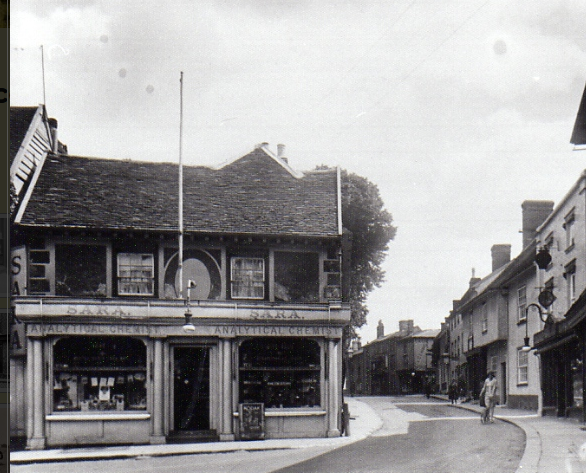
a very long time. Herbert Sara was the chemist from 1912 to
about 1930.
(Framlingham Historical Archive)
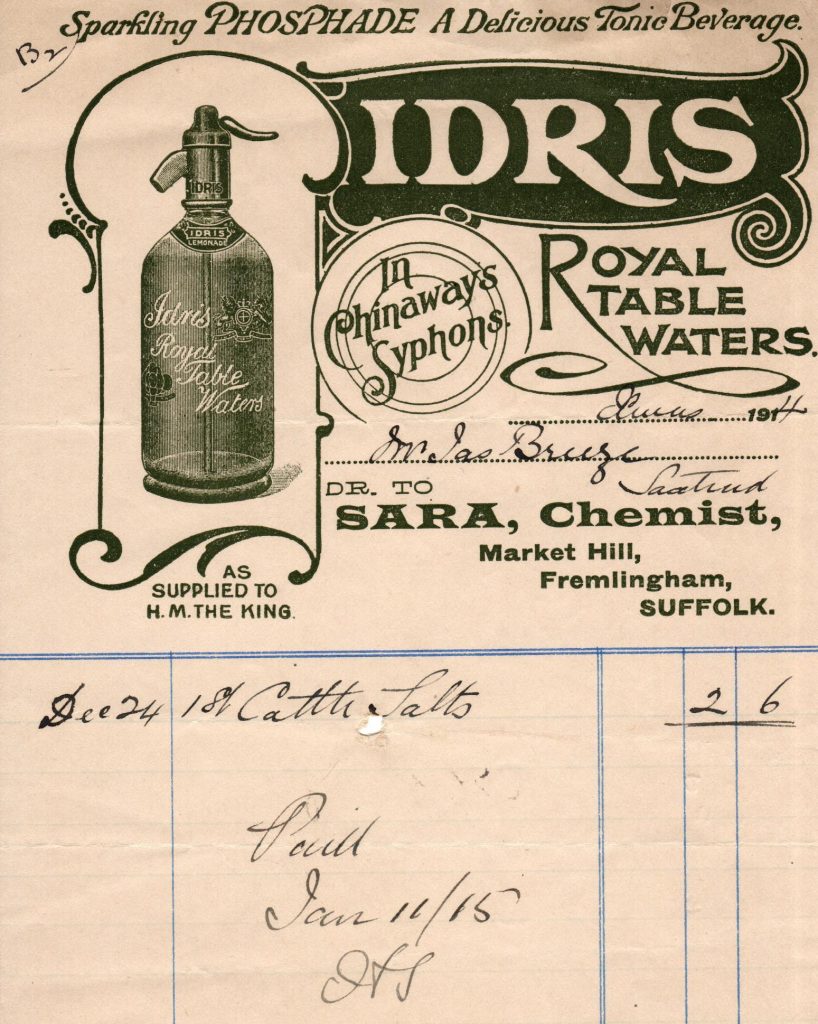
A range of medicines was available, stored in specie jars and the smaller ‘shop rounds’. Powders were mixed with liquorice and glucose to form a pliable paste which was then used to make pills.
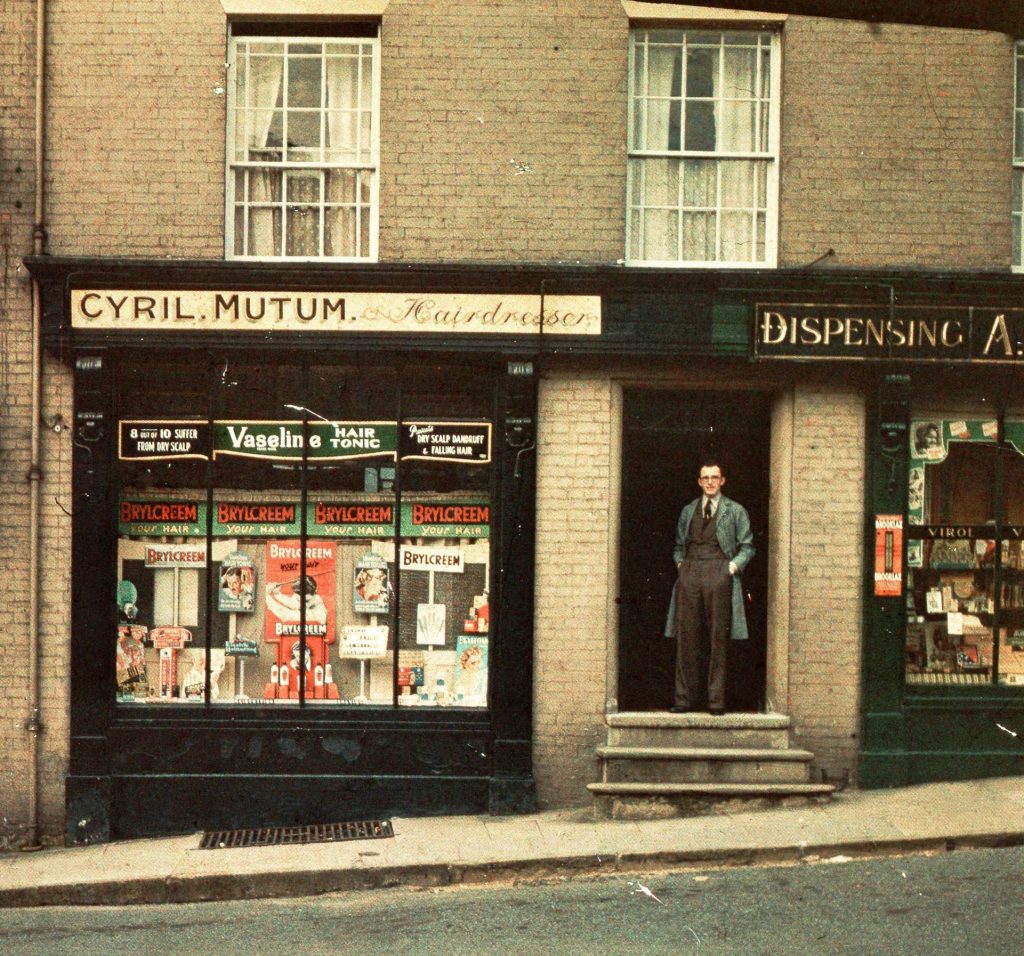
c.1939. Although primarily of Cyril Mutum’s
hairdressing shop, it does show part of A J Last’s
Dispensing chemist on the corner of Church Lane.
(Framlingham Historical Archive)
A pestle, mortar and pill-making machine were essential parts of a chemist’s equipment. A popular medicine was laudanum, made from morphine dissolved in alcohol, which could be taken on its own or with water or wine. It was also mixed with syrup and used as a ‘quietening’ mixture for children.
The chemist’s shop we know today is located on the corner of Market Hill and Church Street. This site was bought by Henry Clutten in 1832 and has been a chemist’s since that time. White’s directory of 1844 lists Henry Clutten as a chemist on the Market Hill. The next directory of 1855 now has Henry Gooch as the chemist. In 1866, Clutten sold the premises to Henry Gooch and his brother, who was a chemist. His name is listed in several trade directories up to 1888.
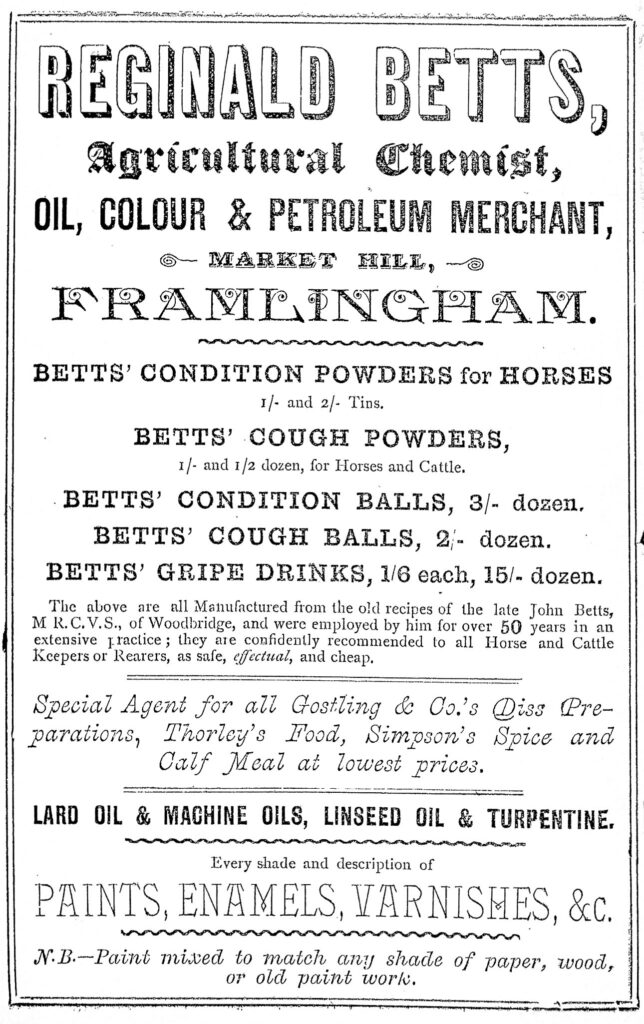
In 1892, Gooch’s executors ‘beg to inform their friends and the public generally that, having disposed of their business to Mr Reginald Betts, they hope the support so freely accorded them for the past 40 years may be continued to the successor. Mr Betts is in possession of all trade books and private recipes, and our friends can obtain the family medicines as heretofore.’ The new chemist was familiar with the profession as his father John was a chemist in Woodbridge. The Pharmacy Act of 1896 required all newcomers to the profession to pass examinations. They would then be able to dispense various chemicals including scheduled poisons, which were sold in green bottles. Betts’ accounts proudly proclaim that he is ‘dispensing chemist by examination’.
Reginald’s time in Framlingham was troubled and finally ended in tragic circumstances on the other side of the world. In 1893 he married 22-year old Edith Dring of Boundary Farm, Cransford, but less than three years later, on 6 January 1896, Edith died after she ‘succumbed to a distressing malady’. Her death certificate records that she died of ‘phthisis’ (tuberculosis) which she had for ‘some years’. Within about 18 months, in late 1897, he married Florence Pankhurst of Norwich and they had a son, Maurice, born in 1899. Her father was Edward Pankhurst of Town Close, Norwich.
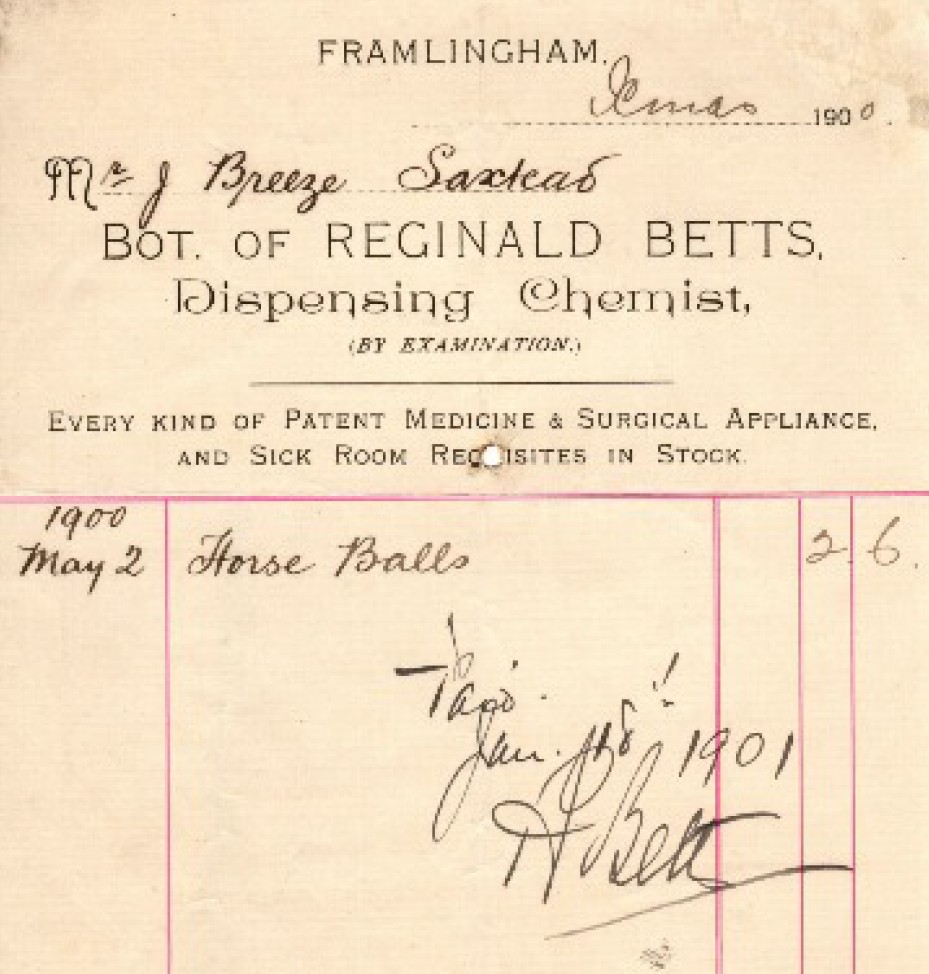
Betts had started his business with borrowed capital but later got into financial difficulty and tried to borrow money from friends. Matters became critical in December 1901 when he was advised to put himself in the hands of his several creditors, which included major names such as the Anglo American Oil Company and Kodak through to the local businesses of S G Carley and Charles Garrard. It was estimated that his assets were £1,075 against debts of £1,464. His London solicitor advised that the details were not sufficiently detailed and that he should return home to complete a fuller assessment. That showed his liabilities were much more than originally thought. At the same time he decided to sell his business and within a week it had been acquired by Gostling and Co. of Diss.
Betts did not attend the hearing in Ipswich and was declared bankrupt on 18 December when his whereabouts were stated to be unknown and that he had left home with intent ‘to defeat or delay his creditors’.
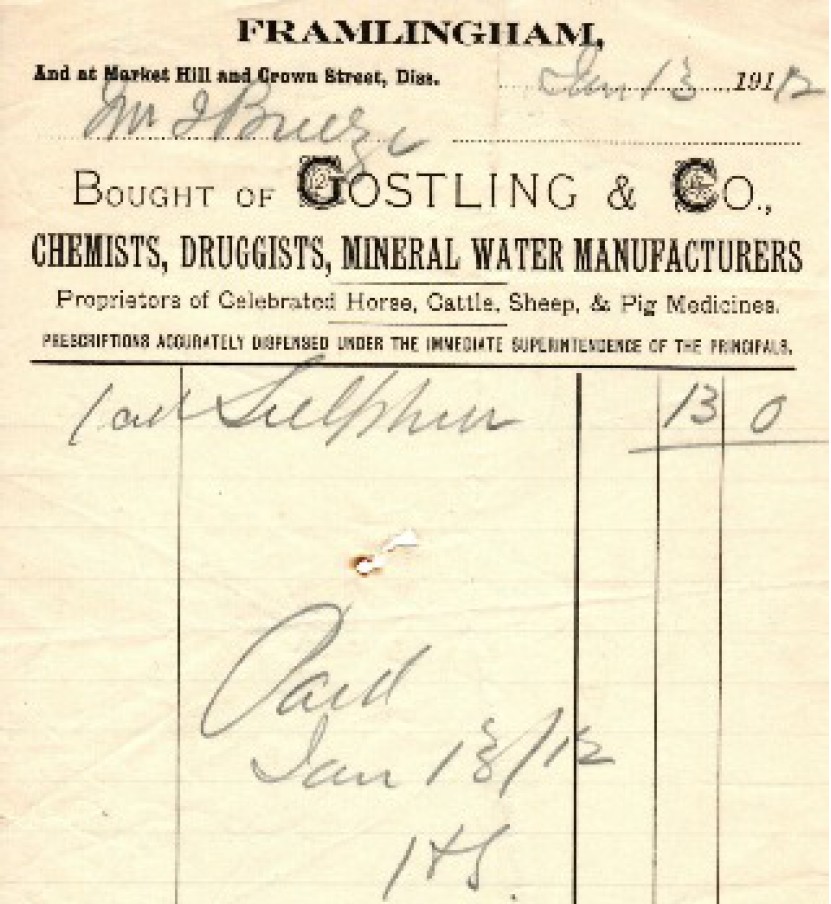
His movements are not fully known but what is certain is that he assumed the false name of Robert Hayward, because letters later found in his possession were addressed to that name at the Albany Hotel, Ryde, along with a ticket to Southampton. He sailed from there in early January on the SS Bremen, arriving in Sydney on 12 February. He is recorded as living at a boarding house from 3 April 1902, where he told the proprietor he was looking for work as a chemist and showed him papers in the name of Reginald Betts.
Some days later his landlord had seen him lying on his bed and assumed he was intoxicated. However, the next day there was no reply from his room and on entering he found Betts was dead. Doctor Jamieson said the body showed signs of poisoning and there was a strong smell of chlorodyne. The cause of death was opium poisoning. In his room three bottles were found which had the smell of chlorodyne, along with the letters previously mentioned. A jury returned that death was due to poison, ‘but there was not sufficient evidence to show if self administered or with determination towards suicide’.
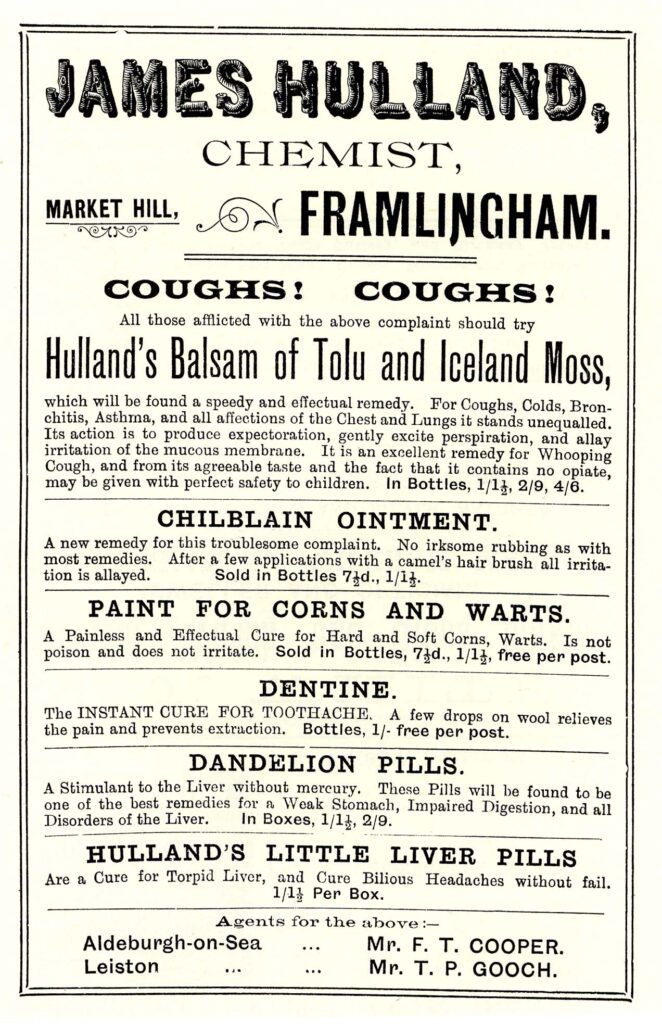
In fleeing to Australia Betts was presumably looking to establish a new life. Although declared bankrupt he likely had money from the sale of his business. But it was no doubt difficult for him to get work as a chemist under an assumed name, and it was perhaps this that precipitated a downward spiral. His wife’s brother had emigrated to Australia in the 1880s, and it is possible that Reginald and Florence had also visited at some time. If he was planning to start a new life, his wife and baby son were not to be any obvious part of it.
Only a few months earlier the 1901 census tells us that Florence was living at the Market Hill premises with Reginald and their one – year-old son Maurice, together with a servant and a nurse. Her dramatic change in circumstances probably necessitated a return to her parents in Norwich. In April 1903 Florence married Herbert Bullard at Easton St Andrew, Norwich — her second marriage in the city within seven years.
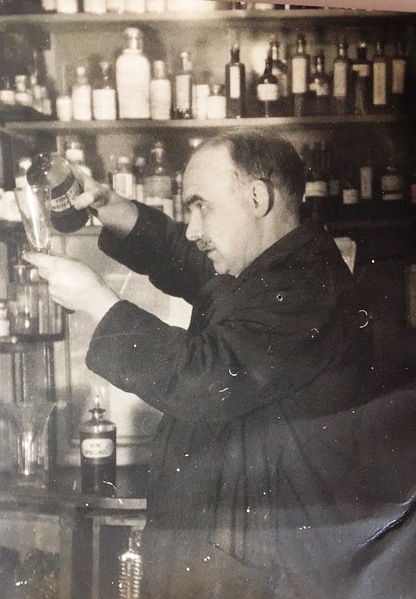
Gostlings had other branches and was a forerunner of such businesses with multiple outlets. Their manager, Herbert Sara, ran the Framlingham branch until 1912 when he took it over himself and traded under that name until 1931. G W Hales then acquired the business, with Mr Bennet as manager until around 1950 when C H Stevens took over. There have been many changes since then, all with the common element of serving the residents of Framlingham with their medicinal needs from the same location on the corner of Market Hill and Church Street.
A brief timeline for the two locations follows.
| Church Lane and Bridge Street | Market Hill |
|---|---|
| Thomas Manning c. 1858 to 1863 Henry Hutchins 1863 to 1879 James Hulland 1879 to 1904 G T Cooper (tailor) A J Last 1929 to c. 1950 | Henry Clutten 1832 to c. 1855 Henry Gooch c.1855 to 1892 Reginald Betts 1892 to 1901 Gostling 1901 to 1912 Sara 1912 to 1931 G W Hales 1931 to c. 1950 C H Stevens 1950s |
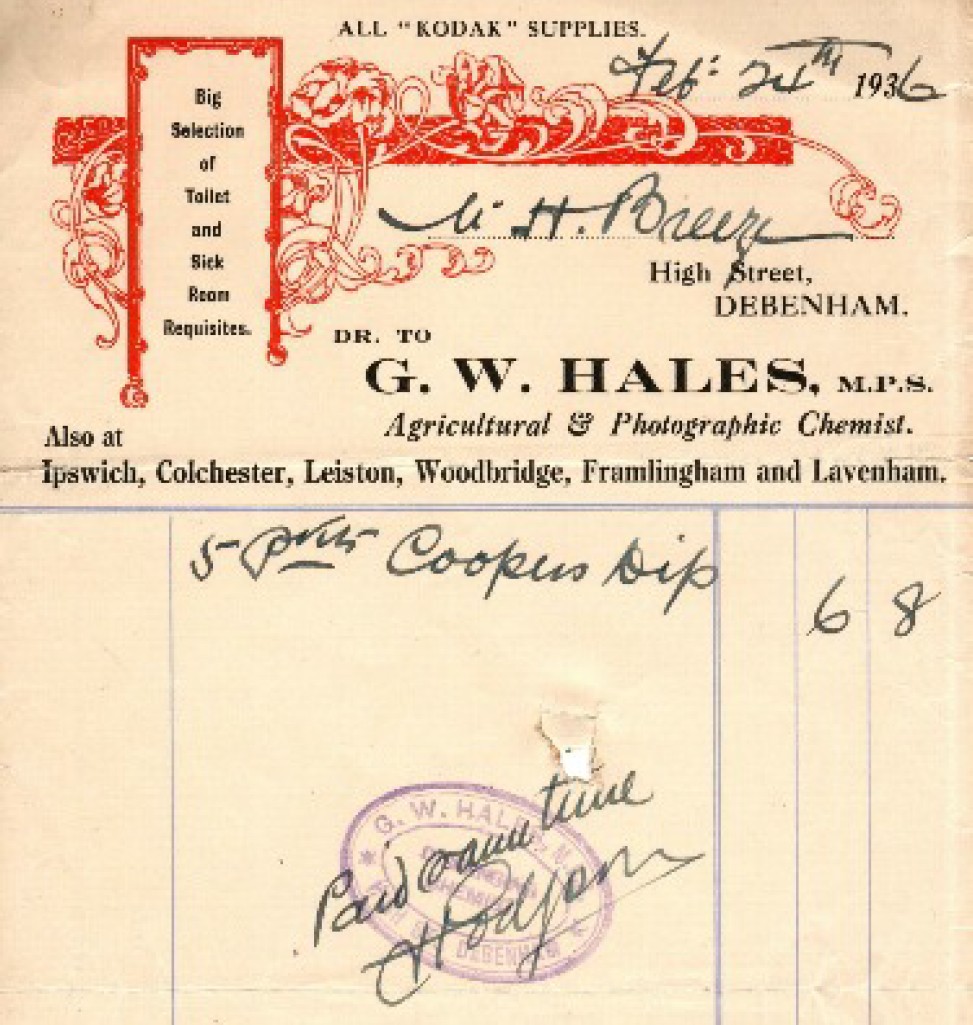
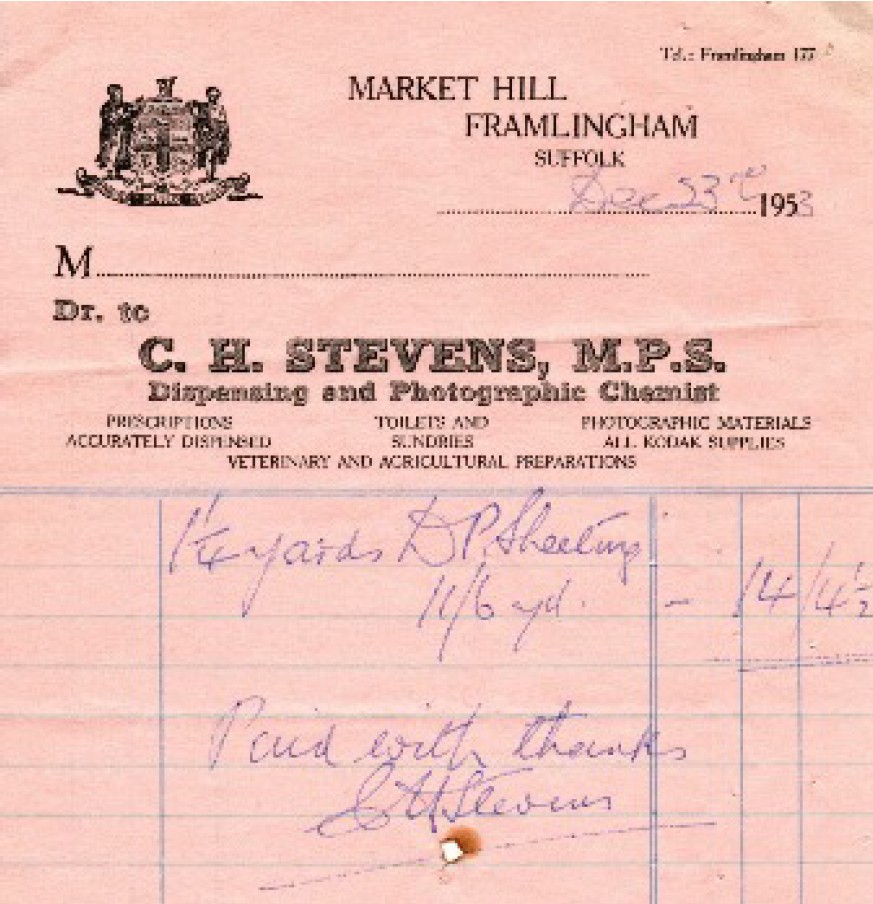
Principle Sources
- Bathurst Free Press and Mining Journal
- County Directories
- Diss Express
- East Anglian Daily Times
- Framlingham Weekly News
- Lambert’s Family Almanacs
- Public Record Office, Victoria, North Melbourne.
Footnote
- See the March 2021 edition of the FRAM Newsletter. ↩︎
